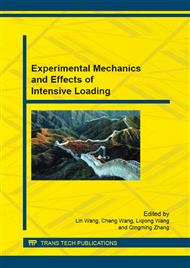[1]
M. Zhou, S.J. Hu, H. Zhang, Critical specimen sizes for tensile-shear testing of steel sheets, Weld. J. 78(1999) 305–312.
Google Scholar
[2]
H. G. Yang, Y. S. Zhang, X.M. Lai, An experimental investigation on critical specimen sizes of high strength steels DP600 in resistance spot welding, Materials and Design. 29 (2008) 1679–1684.
DOI: 10.1016/j.matdes.2008.04.009
Google Scholar
[3]
Test Methods for Evaluating the Resistance Spot Welding Behavior of Automotive Sheet Steel Materials. AWS D8. 9M: 2012, American Welding Society.
Google Scholar
[4]
Specification for resistance welding of carbon and low-alloy steels. AWS C1. 4M/C1. 4: 2009, American Welding Society.
Google Scholar
[5]
Specimen dimensions and procedure for shear testing resistance spot, seam and embossed projection welds[S]. ISO 14273:2000,International standard.
DOI: 10.3403/02521576
Google Scholar
[6]
Method of tensile test for welded joint. GB 2651-89 General Administration of Quality Supervision, Inspection and Quarantine of People's Republic of China, China National Standardization Management Committee.
Google Scholar
[7]
Method of tensile test for welded joint. GB 2651-2008 General Administration of Quality Supervision, Inspection and Quarantine of People's Republic of China, China National Standardization Management Committee.
Google Scholar
[8]
Welding, resistance: spot and seam, SAE-AMS-W-6858A 2000, American Welding Society.
Google Scholar
[9]
Military specification welding, resistance: spot and seam, MIL-W-6858D 1992, Departments and Agencies of the Department of Defense.
Google Scholar
[10]
Resistance spot welding and projection welds-Destructive testing of welds-Specimen dimensions and procedure for impact shear test and cross-tension testing, BS EN ISO 14323: 2006, International standard.
DOI: 10.3403/30105266u
Google Scholar
[11]
J, Heuschkel, The expression of spot-weld properties, Weld J, 31(1952) 931–943.
Google Scholar
[12]
J. M. Sawhill, J.C. Baker, Spot weldability of high-strength sheet steels, Weld. J. 59(1980) 19–30.
Google Scholar
[14]
Y. J. Chao, Ultimate strength and failure mechanism of resistance spot weld subjected to tensile, shear, or combined tensile/shear loads. ASME J. Eng. Mater. Technol. , 125(2003) 125–32.
DOI: 10.1115/1.1555648
Google Scholar
[14]
Y.J. Chao, Failure mode of spot welds: interfacial versus pullout, Sci. Technol. Weld. Join. , 8(2003) 133–137.
Google Scholar
[15]
M. Pouranvariand, S. P. H. Marashi, Failure of resistance spot welds: tensile shear versus coach peel loading conditions, Ironmaking& Steelmaking, 39(2012) 104-111.
DOI: 10.1179/1743281211y.0000000066
Google Scholar
[16]
S.H. Lin, J. Pan, S.R. Wu. Failure loads of spot welds under combined opening and shear static loading conditions, International Journal of Solids and Structures, 39(20001) 19-39.
DOI: 10.1016/s0020-7683(01)00187-1
Google Scholar


